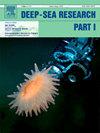在遥远的赤道太平洋的深水珊瑚中,肉眼和荧光检测不到的微塑料积累
IF 2.1
3区 地球科学
Q2 OCEANOGRAPHY
Deep-Sea Research Part I-Oceanographic Research Papers
Pub Date : 2025-06-28
DOI:10.1016/j.dsr.2025.104550
引用次数: 0
摘要
水生环境中的微塑料丰度是一个公认的现象,有可能通过受污染的水和沉积物破坏生态过程,包括食物网和病媒疾病。随着人们呼吁加强对偏远和深海海洋的保护,建立相对污染的基线,并确定是否有相对不受微塑料影响的地方是很重要的。深海珊瑚是异养生态系统工程师,具有捕获和摄入微塑料颗粒的潜力。在这项研究中,我们询问了在人类偏远、完全受保护的地方的深海珊瑚是否使用视觉和荧光激活技术证明了微塑料摄入的证据。我们没有发现微塑料积累的有力证据。尽管有这些具体的结果,但在偏远的深海系统中保持无塑料环境将受益于限制或防止人为活动的保护措施的增加。因此,公海和深水海洋保护区应考虑将减少污染风险纳入其潜在利益之中。本文章由计算机程序翻译,如有差异,请以英文原文为准。
Microplastic accumulation visually and fluorescently undetectable within deepwater corals of the remote equatorial Pacific
Microplastic abundance in aquatic environments is a well-established phenomena, with the potential to disrupt ecological processes, including food webs and vector diseases via contaminated water and sediments. With the call for increasing ocean protection in remote and deep-waters, it is important to establish baselines of relative contamination, and to identify whether or not there are places relatively free from microplastic impact. Deep-sea corals are heterotrophic ecosystem engineers that have the potential to capture and ingest microplastic particles. In this study, we asked whether or not deep-sea corals in humanly remote, fully-protected, locations demonstrate evidence of microplastic ingestion using visual and fluorescence-enabled techniques. We found no strong evidence for microplastic accumulation. Despite these specific results, maintaining plastic-free environments in remote deep-sea systems will benefit from increased protections that limit or prevent anthropogenic activities. As such, open ocean and deep-water marine protected areas should consider including decreased pollution risk among their potential benefits.
求助全文
通过发布文献求助,成功后即可免费获取论文全文。
去求助
来源期刊
CiteScore
4.60
自引率
4.20%
发文量
144
审稿时长
18.3 weeks
期刊介绍:
Deep-Sea Research Part I: Oceanographic Research Papers is devoted to the publication of the results of original scientific research, including theoretical work of evident oceanographic applicability; and the solution of instrumental or methodological problems with evidence of successful use. The journal is distinguished by its interdisciplinary nature and its breadth, covering the geological, physical, chemical and biological aspects of the ocean and its boundaries with the sea floor and the atmosphere. In addition to regular "Research Papers" and "Instruments and Methods" papers, briefer communications may be published as "Notes". Supplemental matter, such as extensive data tables or graphs and multimedia content, may be published as electronic appendices.

 求助内容:
求助内容: 应助结果提醒方式:
应助结果提醒方式:


